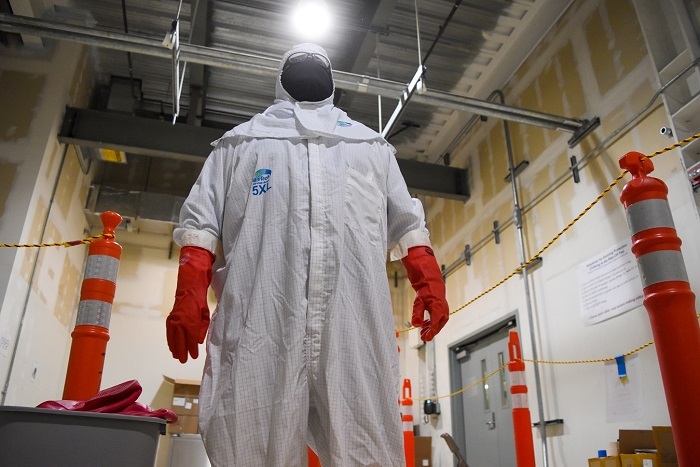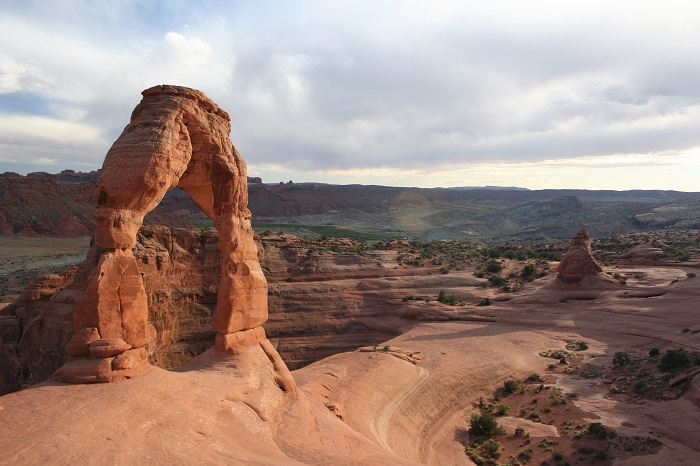 Waste Treatment and Immobilization Plant Commissioning Technician Quirino Quiroga learns to don and doff personal protective equipment as part of radiological worker training. This training signifies another important step toward commissioning and eventual operations for the Direct-Feed Low-Activity Waste process.
RICHLAND, Wash. –The word “rad” has finally arrived at the EM Office of River Protection (ORP) Waste Treatment and Immobilization Plant at the Hanford Site, and it’s not for a 1980s throwback.
Instead, more than 450 workers at the plant will receive radiological, or “rad,” worker training as the plant nears commissioning, when operators will run a nonradioactive waste simulant through the plant to ensure systems are working properly.
“Rad worker training is a constant across the rest of Hanford,” said Mat Irwin, ORP deputy assistant manager for the plant. “But it’s new at the plant as facility construction is finished, Analytical Laboratory startup is complete, and startup testing for the Low-Activity Waste Facility and Effluent Management Facility is nearly complete. The team is well prepared to complete training prior to cold and hot commissioning.”
During commissioning, workers will need to demonstrate proper rad safety performance as if the plant were treating radioactive waste from Hanford’s large underground tanks. The required training will help personnel maintain knowledge and skills.
“We are preparing our employees to safely operate the plant and turn tank waste into glass,” said Kelly Neal, deputy safety and health manager for Hanford subcontractor Waste Treatment Completion Company. “Starting the training early is important to make sure our team is ready for commissioning.”
The addition of rad worker training signifies another important step toward commissioning and eventual operations for the Direct-Feed Low-Activity Waste process, a system of interdependent projects and infrastructure improvements, managed and highly integrated as a program, that must operate together to vitrify tank waste, which means to immobilize it within glass.
“The need for this training now demonstrates how close we are to commissioning,” said Irwin. “It’s exciting to begin seeing the permanent plant training programs being implemented.”
The training began this month and is scheduled for completion by the fall. The training is required for anyone who might access radiological areas, work with radioactive materials, or operate radiation-generating devices. Training consists of classroom modules and a written exam, as well as an onsite session for recognizing signs, postings, and barricades, and entering and exiting radiological areas. More advanced training will be held for employees learning how to don and doff personal protective equipment for entering and exiting contamination areas.
View individual plant facilities and their interior spaces using a self-guided Hanford Virtual Tour.
-Contributors: George Rangel, Staci West
Arches National Park delivers fill dirt to the Moab Uranium Mill Tailings Remedial Action Project.
MOAB, Utah – EM’s Moab Uranium Mill Tailings Remedial Action (UMTRA) Project and the National Park Service continue to find ways to help each other in a growing partnership that has improved local revegetation efforts.
Arches National Park recently delivered excess soil to the Moab Site that came from an area near one of the park’s most iconic landmarks.
During large storms, sediment close to the popular Delicate Arch tended to wash onto the road, preventing tourists and others from getting through. Park staff dug out a nearby drainage so material could flow properly, but they needed to figure out what to do with the extra material.
 At 46 feet high, Delicate Arch is one of Arches National Park’s most popular geologic features.
Moab’s revegetation staff offered to take eight dump trucks full of the park’s dirt. It was a convenient arrangement, as the Moab Site is located across the highway from Arches.
Moab staff members plan to mix the transferred material with soils onsite that have a high clay and salt content and struggle to support plant growth. The new material is expected to boost soil quality and texture by diluting salinity and improving drainage.
“It’s great to work with our neighbors on projects with mutual benefit,” Moab UMTRA Project Revegetation Technician Katrina Lund said. “We’re excited to see how this fill dirt can help improve soil conditions onsite.”
In the future, Moab staff will consider planting Inland saltgrass in the areas where the fill dirt was added. The native perennial can withstand drought and flood and help stabilize the soil, aiding with dust suppression.
-Contributor: Honora Thompson
|